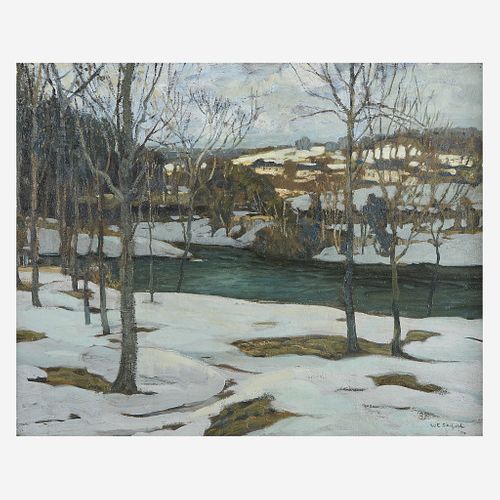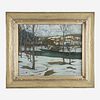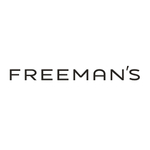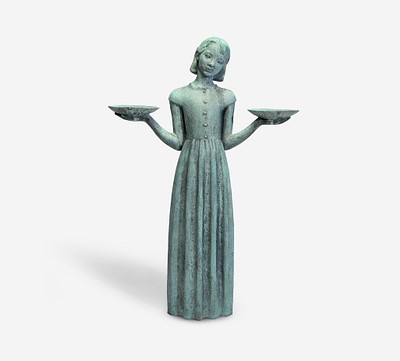Walter Elmer Schofield (American, 1867–1944) River in Snow
About Seller
2400 Market St
Philadelphia, PA 19147
United States
Established in 1805, Freeman’s Auction House holds tradition close, with a progressive mind-set towards marketing and promotion, along with access to a team of top experts in the auction business. And now with offices in New England, the Southeast, and on the West Coast, it has never been easier to ...Read more
Two ways to bid:
- Leave a max absentee bid and the platform will bid on your behalf up to your maximum bid during the live auction.
- Bid live during the auction and your bids will be submitted real-time to the auctioneer.
Bid Increments
| Price | Bid Increment |
|---|---|
| $0 | $25 |
| $500 | $50 |
| $1,000 | $100 |
| $2,000 | $200 |
| $3,000 | $250 |
| $5,000 | $500 |
| $10,000 | $1,000 |
| $20,000 | $2,000 |
| $30,000 | $2,500 |
| $50,000 | $5,000 |
| $100,000 | $10,000 |
About Auction
Jun 6, 2021
Freeman’s is pleased to present Sylvia Shaw Judson’s Bird Girl, the highlight of the June 6 auction. In addition to the sculpture, this auction will also feature several notable works by significant American artists, including Daniel Garber, Norman Rockwell, Edward Redfield, and William Harnett. Freeman's info@freemansauction.com
- Lot Description
Walter Elmer Schofield (American, 1867–1944) River in Snow
Signed and dated 'W E Schofield/'06' bottom right, oil on canvas
24 x 30 in. (61 x 76.2cm)
In a Phillip N. Yates-style frame.Provenance
The Artist.
By descent in the Schofield family.
Cheffins, Cambridge, sale of March 7, 2013, lot 453.
Acquired directly from the above sale.
Private Collection, Connecticut.
Footnote:Note
Walter Schofield may have been the most international of all the Pennsylvania Impressionists. Born in Philadelphia in 1867, he studied at the Pennsylvania Academy of the Fine Arts from 1889 to 1892, and spent most of his life between two continents: while he would record the frosty and picturesque winters in the Delaware Valley from April to October, he would spend his summers in England, specifically Cornwall, where he painted the quaint hamlets he is known for today. The stately manor he stayed at, Godolphin, also provided a desirable subject throughout the years.
The following two works illustrate the versatility of the artist, who could depict the changing effects of light on the landscape no matter the season, whether it was a shaded brook in Pennsylvania, or the rugged shore of Maine, where he was also frequently painting. One can sense the similarity between Schofield's bold and vigorous style in each painting and that of Redfield, the Father of Pennsylvania Impressionsm. If the two started off as close friends, often painting near each other, Schofield's exploration of the plein air motif, which he would translate on large-size canvas irritated Redfield, who considered his touch unique, and caused a schism between the two artists.
Painted in 1906, River in Snow recalls Schofield's first real success from 1899, Winter (now at the Pennsylvania Academy of the Fine Arts). It is a typical early snow scene, with a quiet and intimate mood reminiscent of paintings of icebound pools by John Henry Twachtman. As such, it appears more Tonalist in execution than Impressionistic, as exemplified by the soft, silvery hues used to depict the ice-cold river. Contrary to Winter however, Schofield introduces a perspective to his painting by inserting the view of a nearby village in the distance, which enables the painting to breathe and open-up. The work was most likely painted in Pennsylvania, outdoors, and as pays homage to Redfield, who also liked to depict such close-up views of streams in the forest, not too far from the nearest village often represented in one of the corners of the canvas.
Rocks and Sea, Chebeague Island, Maine is another strong example of Schofiel's talent, and uses many of the compositional tools the artist used in his Cornish paintings. Both locales shared the same ruggedness, which appealed greatly to Schofield. Without any architecture in sight, simply rocks, surf and weed, Schofield immortalizes a vision of nature freed from mankind - a trait often visible in his paintings, which are usually devoid of any human figures. Such a coast scene offers a dramatic spectacle; that of massive rock formations wrestling against the powerful, pounding waves.
Condition report:The unlined canvas in overall very good condition. With minuscule, pinpoint holes in all four corners. Examination under UV light reveals remnants of green varnish at center (relatively minor). With pinpoint, localized restoration at bottom left (inpainted flake), at upper center (along top outer edge), at upper left (small touch-ups in the branches). With some paint remnants at upper right, along right outer edge.
Frame: 35 1/4 x 41 1/2 x 2 1/2 in.
- Shipping Info
-
No lot may be removed from Freeman’s premises until the buyer has paid in full the purchase price therefor including Buyer’s Premium or has satisfied such terms that Freeman’s, in its sole discretion, shall require. Subject to the foregoing, all Property shall be paid for and removed by the buyer at his/ her expense within ten (10) days of sale and, if not so removed, may be sold by Freeman’s, or sent by Freeman’s to a third-party storage facility, at the sole risk and charge of the buyer(s), and Freeman’s may prohibit the buyer from participating, directly or indirectly, as a bidder or buyer in any future sale or sales. In addition to other remedies available to Freeman’s by law, Freeman’s reserves the right to impose a late charge of 1.5% per month of the total purchase price on any balance remaining ten (10) days after the day of sale. If Property is not removed by the buyer within ten (10) days, a handling charge of 2% of the total purchase price per month from the tenth day after the sale until removal by the buyer shall be payable to Freeman’s by the buyer. Freeman’s will not be responsible for any loss, damage, theft, or otherwise responsible for any goods left in Freeman’s possession after ten (10) days. If the foregoing conditions or any applicable provisions of law are not complied with, in addition to other remedies available to Freeman’s and the Consignor (including without limitation the right to hold the buyer(s) liable for the bid price) Freeman’s, at its option, may either cancel the sale, retaining as liquidated damages all payments made by the buyer(s), or resell the property. In such event, the buyer(s) shall remain liable for any deficiency in the original purchase price and will also be responsible for all costs, including warehousing, the expense of the ultimate sale, and Freeman’s commission at its regular rates together with all related and incidental charges, including legal fees. Payment is a precondition to removal. Payment shall be by cash, certified check or similar bank draft, or any other method approved by Freeman’s. Checks will not be deemed to constitute payment until cleared. Any exceptions must be made upon Freeman’s written approval of credit prior to sale. In addition, a defaulting buyer will be deemed to have granted and assigned to Freeman’s, a continuing security interest of first priority in any property or money of, or owing to such buyer in Freeman’ possession, and Freeman’s may retain and apply such property or money as collateral security for the obligations due to Freeman’s. Freeman’s shall have all of the rights accorded a secured party under the Pennsylvania Uniform Commercial Code.
-
- Buyer's Premium



 EUR
EUR CAD
CAD AUD
AUD GBP
GBP MXN
MXN HKD
HKD CNY
CNY MYR
MYR SEK
SEK SGD
SGD CHF
CHF THB
THB













